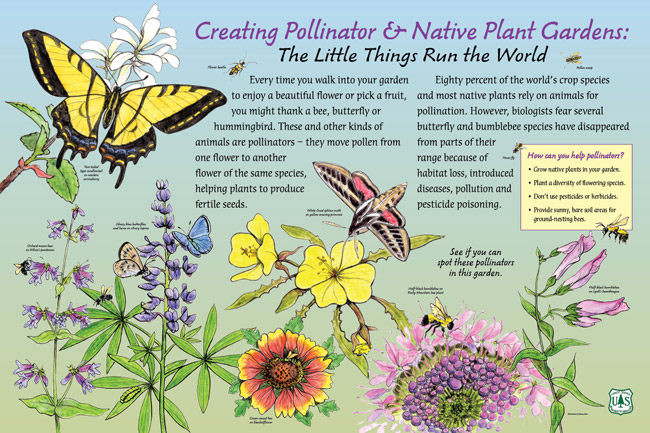
What is pollination and who are the pollinators?
Source: Pollinator Partnership
Pollination occurs when pollen is moved within flowers or carried from flower to flower by pollinating animals such as birds, bees, bats, butterflies, moths, beetles, or other animals, or by the wind.
Why does pollination matter to us?
- Worldwide, roughly 1,000 plants grown for food, beverages, fibers, spices, and medicines need to be pollinated by animals in order to produce the goods on which we depend.
- Foods and beverages produced with the help of pollinators include: apples, blueberries, chocolate, coffee, melons, peaches, potatoes, pumpkins, vanilla, almonds, and tequila.
- In the United States, pollination by honey bees, native bees, and other insects produces $40 billion worth of products annually.
Are pollinators in trouble?
- Worldwide there is disturbing evidence that pollinating animals have suffered from loss of habitat, chemical misuse, introduced and invasive plan and animal species, and diseases and parasites.
- Many pollinators are federally “listed species,” meaning that there is evidence of their disappearance in natural areas.
- The U.S. has lost over 50% of its managed honeybee colonies over the past 10 years.
- A lack of research has hindered our knowledge about the status of pollinators. The E.U. has been so concerned that they have invested over $20 million investigating the status of pollinators in Europe.
What can you do to promote and protect pollinators?
- Plant for pollinators
- Cultivate native plans, especially those that provide nectar and larval food for pollinators – FREE Ecoregional Pollinator Planting Guides
- Install houses for bats and native bees
- Supply salt or mineral licks for butterflies and water for all wildlife
- Reduce pesticide use
- Substitute flower beds for lawns
The Beauty of Pollination
14 Facts About Monarch Butterflies